Enhancing Locomotion in Immersive Virtual Environments
It has often been observed that people have a harder time keeping track of where they are while virtually moving around in VR than when actually walking around in the real world. This is a particular problem when the virtual environment is too large to allow the use of a 1-1 mapping between actual physical motion and the control of one's viewpoint in the virtual world. Over the past years, our group has been investigating the development of natural locomotion methods that help people maintain spatial awareness while exploring large scale immersive virtual environments.
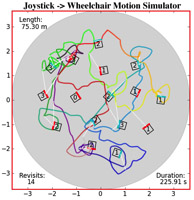
|
Towards Enabling More Effective Locomotion in VR Using a Wheelchair-Based Motion Platform, Loren Puchalla Fiore, Ella Coben, Samantha Merritt, Peng Liu and Victoria Interrante (2013) Joint Virtual Reality Conference of EGVE - EuroVR, pp. 83-90.
[PDF]
[abstract]
|
This paper addresses two questions relevant to the design of effective locomotion methods for VR using a novel wheelchair motion simulation interface. First, we investigate the extent to which people's ability to keep track of where they are in an immersive virtual environment can be facilitated by actual physical movement (rotation and translation) in the context of vehicular travel. Second, we quantitatively analyze various characteristics of the travel paths produced by different types of locomotion control systems to gain insight into the aspects of control that can evoke or impede natural patterns of movement through a virtual environment.
In a within-subjects experiment, we asked 35 volunteers to virtually search through 16 identical-looking boxes randomly placed within a realistically rendered, circularly symmetric virtual room to find 8 hidden targets. Participants performed this task under four different conditions of integrated visual and physical movement, controlled via a joystick interface attached to a motorized wheelchair. In all four cases participants 'drove' their virtual viewpoint using the joystick, but the nature of the accompanying physical movement varied between the conditions. The four conditions were: no physical movement; full physical rotation only; full physical translation and rotation; and 'partial' physical translation and rotation, wherein the extent of the actual physical movement was proportionally reduced relative to the visually-indicated movement.
Analysis of the search results did not find a statistically significant main effect of the physical movement condition on total distance traveled or total number of revisits to previously searched locations. However we did see a trend towards greater search accuracy in the full physical motion condition, with a greater proportion of perfect trials, a smaller proportion of failed searches, fewer boxes revisited on average, and more novel boxes searched before the first revisit in that condition than in the others. Analyzing the paths traveled, we found that the velocity and curvature profiles of the virtual motion paths enabled by our novel joystick-controlled wheelchair motion simulation interface were more qualitatively similar to those produced by natural walking than were travel paths we had previously observed when more basic joystick locomotion control methods were used. This suggests potential benefits in adopting a vehicle-simulation movement control method for joystick locomotion control in VR.
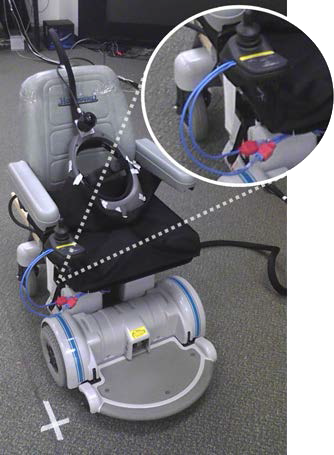
|
Redirected Steering for Virtual Self-Motion Control with a Motorized Electric Wheelchair, Loren Puchalla Fiore, Gerd Bruder, Lane Phillips, Victoria Interrante and Frank Steinicke (2012) Joint Virtual Reality Conference of ICAT - EGVE - EuroVR, pp. 45-48.
[PDF]
[abstract]
|
Redirection techniques have shown great potential for enabling users to travel in large-scale virtual environments while their physical movements have been limited to a much smaller laboratory space. Traditional redirection approaches introduce a subliminal discrepancy between real and virtual motions of the user by subtle manipulations, which are thus highly dependent on the user and on the virtual scene. In the worst case, such approaches may result in failure cases that have to be resolved by obvious interventions, e. g., when a user faces a physical obstacle and tries to move forward. In this paper we introduce a remote steering method for redirection techniques that are used for physical transportation in an immersive virtual environment. We present a redirection controller for turning a legacy wheelchair device into a remote control vehicle. In a psychophysical experiment we analyze the automatic angular motion redirection with our proposed controller with respect to detectability of discrepancies between real and virtual motions. Finally, we discuss this redirection method with its novel affordances for virtual traveling.
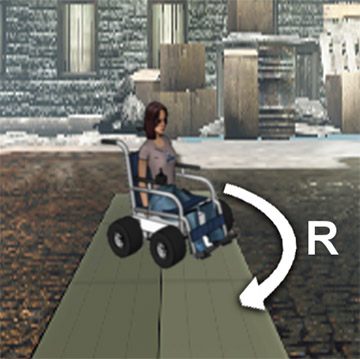
|
Redirecting Walking and Driving for Natural Navigation in Immersive Virtual Environments, Gerd Bruder, Victoria Interrante, Lane Phillips and Frank Steinicke (2012) IEEE Transactions on Visualization and Computer Graphics, 18(4), pp. 538-545.
[PDF]
[abstract]
|
Walking is the most natural form of locomotion for humans, and real walking interfaces have demonstrated their benefits for several navigation tasks. With recently proposed redirection techniques it becomes possible to overcome space limitations as imposed by tracking sensors or laboratory setups, and, theoretically, it is now possible to walk through arbitrarily large virtual environments. However, walking as sole locomotion technique has drawbacks, in particular, for long distances, such that even in the real world we tend to support walking with passive or active transportation for longer-distance travel. In this article we show that concepts from the field of redirected walking can be applied to movements with transportation devices. We conducted psychophysical experiments to determine perceptual detection thresholds for redirected driving, and set these in relation to results from redirected walking. We show that redirected walking-and-driving approaches can easily be realized in immersive virtual reality laboratories, e. g., with electric wheelchairs, and show that such systems can combine advantages of real walking in confined spaces with benefits of using vehiclebased self-motion for longer-distance travel.
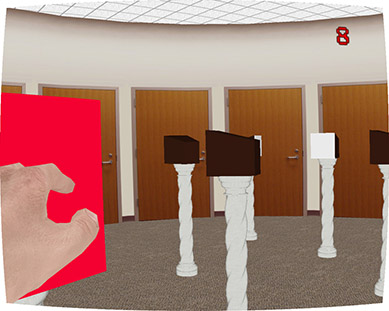
|
From Virtual to Actual Mobility: assessing the benefits of active locomotion through an immersive virtual environment using a motorized wheelchair, Amelia Nybakke, Ramya Ramakrishnan and Victoria Interrante (2012) IEEE Symposium on 3D User Interfaces, pp. 27-30.
[PDF]
[abstract]
|
As we move around, in a real or virtual environment, the process of keeping track of where we are, in relation to the portions of the environment that are out of view, is referred to as spatial updating. Studies have shown that in the real world, when we use real walking to get around, this process is both effortless and automatic, but that in virtual environments, when purely virtual methods of locomotion are used, the accuracy and ease of spatial updating is significantly diminished. In this paper, we present the results of an experiment intended to assess the impact, on spatial updating performance, of enabling people to physically move about in an immersive virtual environment using a motorized wheelchair. This study is motivated by an interest in probing the potential of re-directed driving as an alternative method for enabling people to effectively explore a relatively larger virtual space while physically moving about in a smaller actual space.
A total of 24 participants in our within-subjects experiment traveled through a 24? wide circularly symmetric virtual room, searching the contents of 16 randomly positioned and oriented boxes to locate 8 hidden targets, using each of the following four locomotion methods: real walking (R), virtual translation with real rotation by standing and using a body-worn joystick (S), real driving in a motorized wheelchair (W), and virtual translation with real rotation by sitting in a swivel chair and using a joystick mounted on one of its arms (J). We computed four measures of search efficiency: total distance traveled, total number of targets revisited, proportion of perfect trials, and total search time.
Overall, we found that performance was significantly better with real walking than with either of the virtual travel methods, consistent with most previous findings, and that performance with the wheelchair was intermediate. These results suggest some advantage in enabling actual, as opposed to purely virtual, translational movement in a locomotion interface, and lend support to the potential viability of a re-directed driving implementation.
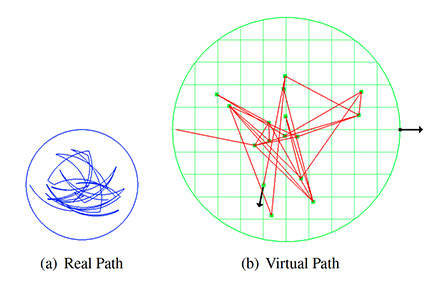
|
Adaptive Re-Directed Walking in a Virtual World, Jack Goldfeather and Victoria Interrante (2012) IEEE VR Workshop on Perceptual Illusions in Virtual Environments, pp. 17-20.
[PDF]
[abstract]
|
Redirected walking enables the physical exploration of large virtual environments within the confines of more limited physical spaces. In this paper, we present a novel method for adaptively determining an appropriate mapping from a linear path in a larger virtual environment into a curved path in a smaller tracked space that simultaneously integrates the use of both rotational and translational offsets.
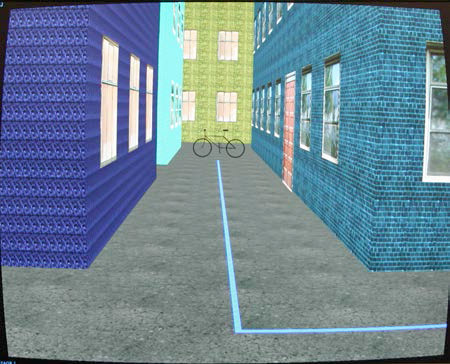
|
A Quantitative Assessment of the Impact on Spatial Understanding of Exploring a Complex Immersive Virtual Environment using Augmented Real Walking versus Flying, Victoria Interrante, Eleanor O'Rourke, Leanne Gray, Lee Anderson and Brian Ries (2007) Eurographics Workshop on Virtual Environments - Short Papers and Posters, pp. 75-78.
[PDF]
[abstract]
|
When an immersive virtual environment spans an area that is larger than the available physical space for real walking, one may use an 'augmented walking' method such as Seven League Boots to enable participants to explore the space while gaining proprioceptive feedback that is similar to what they would experience with normal walking. In this paper, we present the results of a preliminary experiment in which we seek to quantitatively assess the extent to which participants are able to make more accurate spatial judgments about the locations of previously-seen targets in a complicated virtual city environment, experienced using a head-mounted display, after traveling to them using augmented real walking ('boots') versus virtual walking enabled by a button press on a hand-held wand. In a series of trials, we ask participants to follow paths of increasing complexity from a home base to different hidden targets in the environment and back. At each endpoint, with the path markings turned off, we ask participants to point, through the intervening alleyway walls, to the location they believe they started from. Participants are able to make real turns with their bodies in both locomotion conditions, however they are able to make real forward movement only under the augmented walking condition. Each participant completes eight trials under each locomotion condition, with the target locations and the order of experiencing each method counterbalanced between participants. In data collected from six participants so far, we are finding that the median angle error is significantly greater, overall, in the wand locomotion condition than in the 'boots' locomotion condition, and that the errors tend to increase, overall, as the path complexity increases (from two segments to four segments) in the wand locomotion condition but not in the 'boots' locomotion condition.
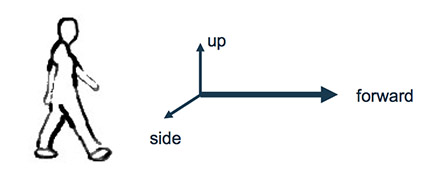
|
Seven League Boots: a new metaphor for augmented locomotion through moderately large-scale immersive virtual environments, Victoria Interrante, Brian Ries, Jason Lindquist and Lee Anderson (2007) IEEE Symposium on 3D User Interfaces, pp. 167-170.
[PDF]
[movie]
[abstract]
|
When an immersive virtual environment represents a space that is larger than the available space within which a user can travel by directly walking, it becomes necessary to consider alternative methods for traveling through that space. The traditional solution is to require the user to travel 'indirectly', using a device that changes his viewpoint in the environment without actually requiring him to move - for example, a joystick. However, other solutions involving variations on direct walking are also possible. In this paper, we present a new metaphor for natural, augmented direct locomotion through moderately large-scale immersive virtual environments (IVEs) presented via head mounted display systems, which we call seven league boots. The key characteristic of this method is that it involves determining a user's intended direction of travel and then augmenting only the component of his or her motion that is aligned with that direction.
After reviewing previously proposed methods for enabling intuitive locomotion through large IVEs, we begin by describing the technical implementation details of our novel method, discussing the various alternative options that we explored and parameters that we varied in an attempt to attain optimal performance. We then present the results of a pilot observer experiment that we conducted in an attempt to obtain objective, qualitative insight into the relative strengths and weaknesses of our new method, in comparison to the three most commonly used alternative locomotion methods: flying, via use of a wand; normal walking, with a uniform gain applied to the output of the tracker; and normal walking without gain, but with the location and orientation of the larger virtual environment periodically adjusted relative to position of the participant in the real environment. In this study we found, among other things, that for travel down a long, straight virtual hallway, participants overwhelmingly preferred the seven league boots method to the other methods, overall.







